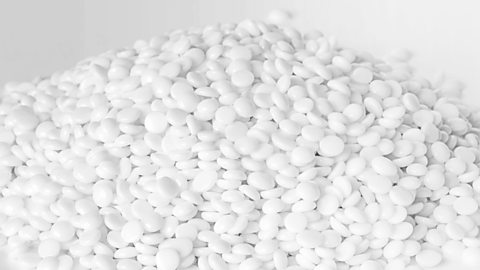Smart materials
While smart materials are modern materials, modern materials are not necessarily smart.
In other words, they change when you do something to them, and when you remove what is causing that change they return to their original form.
Shape-memory alloys (SMA) are metal alloyAn alloy is a mixture of two or more elements, at least one of which is a metal. that can remember their shape when heated. These alloys have been utilised on spectacle frames that spring back to shape if they are squashed.
Nickel titanium (nitinolA smart metal composed of nickel and titanium that contracts when heated or exposed to an electrical current.) is a type of SMA, and it contracts when heated, whereas most metals expand. When braces are made from nitinol, they heat up in the mouth and вҖҳpullвҖҷ on the teeth, so they move with the nitinol.
thermochromicA temperature-sensitive pigment that changes colour when heated. change colour when their temperature changes. The term вҖҳthermoвҖҷ relates to heat, and chroma means colour - so thermochromic pigments change colour when they are heated up. These pigments can be mixed with paint or polymerA large molecule formed from many identical smaller molecules known as monomers. to give the materials the same colour-changing propertiesThe mechanical, physical or optical properties of materials that define how they behave in use. as the pigment. An example of this technology is seen on colour-changing mugs or bath items for children.

Image caption, Body temperature can cause a reaction in thermochromic pigments
Image caption, Thermochromic pigments shown in use in a mug that reveals an image when heat is applied
1 of 2
Photochromic pigments work in a similar way but 'photo' refers to light - so these pigments change their properties when exposed to ultraviolet (UV)Ultraviolet light is a form of radiation that can come from the Sun, or is artificially produced by ultraviolet lamps and bulbs. light. A well-known example would be glasses where the lenses are clear when worn inside a building, but become more like sunglasses when exposed to bright sunlight outside. The same technology has been used in windows to prevent rooms from getting too hot in warm weather.
Quantum-tunnelling composite (QTC) is an insulateTo help maintain the temperature. rubber containing tiny particles of metal. When squashed, the metal particles meet and allow the flow of electric currentThe movement of electrically charged particles, for example, electrons moving through a wire or ions moving through a solution.. As a result, QTC is an insulatorMaterial that is a poor conductor of electricity or heat. when resting and a conductorA material which allows charge to move easily through it. when pressure is applied. It is often used in outdoor applications where water might otherwise damage tiny microswitchesAn electric switch that is actuated by very little physical force through the use of a tipping-point mechanism, sometimes called an 'over-center' mechanism.. It has been used in clothing to control smartphones and portable music players, in power tools to give variable speed controls and in touch-sensitive pads.
Self-healing materials have the ability to repair themselves, which can extend the lifespan of the products that use them. These include polymerA large molecule formed from many identical smaller molecules known as monomers. that can heal knife cuts in themselves, metals that resist corrodeThe destruction of a metal by oxidation or chemical action, eg rusting. and concrete that can heal when cracked.
Ferrofluids can be formed by a magnetic fieldArea surrounding a magnet that can exert a force on magnetic materials. and are being used in hydraulic suspension pistons, with the strength of the magnetic field allowing the suspension to be hard or soft depending on what is necessary. They also have frictionA force that opposes or prevents movement and converts kinetic energy into heat. reducing properties allowing magnetic objects to glide across the surface.
Polymorph is a polymer that becomes malleableCapable of being hammered or pressed into a new shape without being likely to break or return to the original shape. when heated to about 62В°C. When it cools down it becomes hard enough to drill and cut. This makes it perfect for modelling as it can be reheated and formed again. It is also excellent for creating ergonomic handles.

Modern and smart materials are constantly being engineered, so itвҖҷs good to try to keep up to date with the latest developments. They can often be incorporated into new consumer products without people noticing.